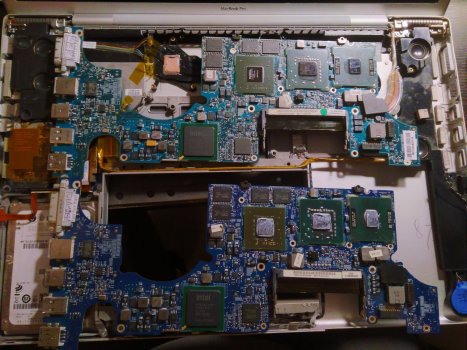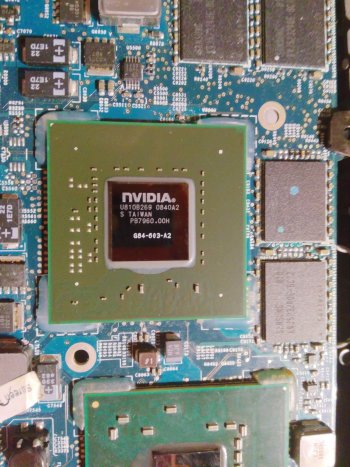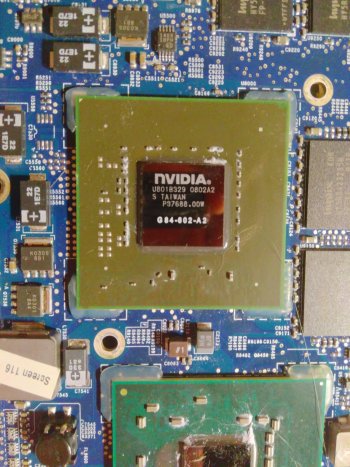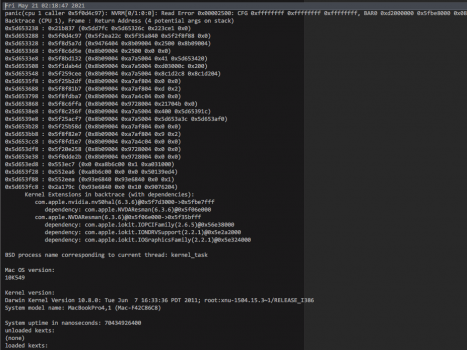(This was supposed to be a thread for sharing some good news. That good news will probably have to wait a while longer.)
Anyhow, if you’ve read this far, I’m thinking this board will have to come right back out and be returned to the seller. I hope I can share much better news sooner than later. I was really looking forward to finally showing a photo of the A1261 and my A1139, running side by side, to post to the Club 17 thread, but I think that moment is going to have to wait.
Pic 1 is the new board (top) over the OEM board (bottom)
Pic 2 is the new board’s GPU (showing the early manufacture date)
Pic 3 is the old board’s GPU (after wiping away the old thermal paste)
Back in 2019, I acquired a 17" A1261 T9300/2.5GHz with hi-res glossy LED LCD in a local trade. I knew it had the faulty OEM GeForce 8600M GT G84-602-A2 chip, and the plan at the time was to set aside that project until I could afford to have the GPU replaced with a G84-603-A2.
Last month, I found a source on eBay which was selling a refurbished logic board. (Their rating is 100%, with feedback in the four figures, and they’ve been around for, well, a few decades. And the product comes with a 30-day warranty. So on that front, I’m not too worried.).
What caught my attention was it was the T9500/2.6GHz variant of the early 2008 boards. I figured what I could do is get one of these boards at a reasonable price and set aside my OEM board until I can procure a T9900 CPU and a fresh G84-603-A2 (and then have both swapped in at the same time by someone who knows their stuff, such as @dosdude1), whilst getting some use out of the remarkably clean A1261 in the meanwhile.
Fast-forward to today.
Although tracking hadn’t been updated, the board arrived and was packaged extremely well. Hurrah! Per the listing photo, the RAM bridge has the green dot and the GPU is the G84-603-A2. But the manufacture date on the GPU is much earlier than I was expecting — really early, as in early-2008 stock.
Next, I pulled out my OEM board, broke out the Noctua paste, and I went to work on swapping boards.
After reassembly, I put in an old testing HDD (running Snow Leopard 10.6.8, an OEM donor from my long-gone 2009 13" MBP). Then I crossed my fingers.
Compared with the OEM board, which has never POSTed, this board chimed as soon as I connected it to the MagSafe. Promising! The screen lit up (also yay!) and a non-verbose boot took about 90 seconds.
Then the screen… went dark.
Huh.
I put the screen underneath a lamp to check if the login window was there (it was). I logged in, but there was still no backlight. I used the lamp light to open the Displays prefPane (which showed max brightness), set the date to today, connected it to wifi, and opened terminal to set nvram to verbose boot. Then I rebooted.
This time, with verbose boot, the backlight stayed on, even with the login window!
I logged in and reached Finder, and it looked as it did when I last used that HDD in 2011. (I migrated to an SSD back then.) Next, I promptly checked to see whether the fans were running in iStat (they were, both around 2200+rpm). Then, I launched a Software Update check. There were a few items which required reboot, so I began to run it.
During the installation of items, the screen began to show weird artifacts and rapid degradation to the point where when moving the cursor, it would only intermittently show that I had moved it. Something was wrong.
Without past experience of seeing a GPU fail, this looked to possibly be just that. The time between powering on and when this appeared was maybe 10 or 15 minutes.
Maybe 30 seconds after the display started to get weird with the artifacts, I force-powered it off with a long power button hold. (Software Update could wait.) The temps on the top case and beneath were typical, “just-run” warm, but otherwise fine (the last temp I read on the CPU before leaving Finder and entering Software Update was a moderate, but average 55°C, while the GPU temp was I think a couple of degrees above that). Again, nothing unusual.
So I let the MacBook Pro rest for a few minutes. Then I powered it on a third time.
Verbose boot completed as usual, but when windowserver started, the display went bright grey, not blue, and it flickered several times, followed by some strange, garbled pixels within the top-left 5-by-5 of the screen. I hard-powered it down again.
Next, being ultra-cautious, I placed a cold pack, fresh from the freezer, underneath the heatsink area, waited until the top case felt cold to the touch, then tried a Safe Boot. As expected, there was no verbose boot, and the grey Apple and spinning clock took its time to finish before the screen showed up as blue. But within maybe 5 or 10 seconds of the blue screen, what appeared to be the cursor pointer in the usual top-left area was vaguely visible under what looked like scan lines. I could not move it. The login window did not appear. Then the system powered off on its own.
Shy of having the 3T108 Graphics Processor Test diagnostic handy (I don’t), I think it’s a good bet this has a faulty GPU despite it being the 603 revision. Are the 603 GPUs known to fail?
Last month, I found a source on eBay which was selling a refurbished logic board. (Their rating is 100%, with feedback in the four figures, and they’ve been around for, well, a few decades. And the product comes with a 30-day warranty. So on that front, I’m not too worried.).
What caught my attention was it was the T9500/2.6GHz variant of the early 2008 boards. I figured what I could do is get one of these boards at a reasonable price and set aside my OEM board until I can procure a T9900 CPU and a fresh G84-603-A2 (and then have both swapped in at the same time by someone who knows their stuff, such as @dosdude1), whilst getting some use out of the remarkably clean A1261 in the meanwhile.
Fast-forward to today.
Although tracking hadn’t been updated, the board arrived and was packaged extremely well. Hurrah! Per the listing photo, the RAM bridge has the green dot and the GPU is the G84-603-A2. But the manufacture date on the GPU is much earlier than I was expecting — really early, as in early-2008 stock.
Next, I pulled out my OEM board, broke out the Noctua paste, and I went to work on swapping boards.
After reassembly, I put in an old testing HDD (running Snow Leopard 10.6.8, an OEM donor from my long-gone 2009 13" MBP). Then I crossed my fingers.
Compared with the OEM board, which has never POSTed, this board chimed as soon as I connected it to the MagSafe. Promising! The screen lit up (also yay!) and a non-verbose boot took about 90 seconds.
Then the screen… went dark.
Huh.
I put the screen underneath a lamp to check if the login window was there (it was). I logged in, but there was still no backlight. I used the lamp light to open the Displays prefPane (which showed max brightness), set the date to today, connected it to wifi, and opened terminal to set nvram to verbose boot. Then I rebooted.
This time, with verbose boot, the backlight stayed on, even with the login window!
I logged in and reached Finder, and it looked as it did when I last used that HDD in 2011. (I migrated to an SSD back then.) Next, I promptly checked to see whether the fans were running in iStat (they were, both around 2200+rpm). Then, I launched a Software Update check. There were a few items which required reboot, so I began to run it.
During the installation of items, the screen began to show weird artifacts and rapid degradation to the point where when moving the cursor, it would only intermittently show that I had moved it. Something was wrong.
Without past experience of seeing a GPU fail, this looked to possibly be just that. The time between powering on and when this appeared was maybe 10 or 15 minutes.
Maybe 30 seconds after the display started to get weird with the artifacts, I force-powered it off with a long power button hold. (Software Update could wait.) The temps on the top case and beneath were typical, “just-run” warm, but otherwise fine (the last temp I read on the CPU before leaving Finder and entering Software Update was a moderate, but average 55°C, while the GPU temp was I think a couple of degrees above that). Again, nothing unusual.
So I let the MacBook Pro rest for a few minutes. Then I powered it on a third time.
Verbose boot completed as usual, but when windowserver started, the display went bright grey, not blue, and it flickered several times, followed by some strange, garbled pixels within the top-left 5-by-5 of the screen. I hard-powered it down again.
Next, being ultra-cautious, I placed a cold pack, fresh from the freezer, underneath the heatsink area, waited until the top case felt cold to the touch, then tried a Safe Boot. As expected, there was no verbose boot, and the grey Apple and spinning clock took its time to finish before the screen showed up as blue. But within maybe 5 or 10 seconds of the blue screen, what appeared to be the cursor pointer in the usual top-left area was vaguely visible under what looked like scan lines. I could not move it. The login window did not appear. Then the system powered off on its own.
Shy of having the 3T108 Graphics Processor Test diagnostic handy (I don’t), I think it’s a good bet this has a faulty GPU despite it being the 603 revision. Are the 603 GPUs known to fail?
Anyhow, if you’ve read this far, I’m thinking this board will have to come right back out and be returned to the seller. I hope I can share much better news sooner than later. I was really looking forward to finally showing a photo of the A1261 and my A1139, running side by side, to post to the Club 17 thread, but I think that moment is going to have to wait.
Pic 1 is the new board (top) over the OEM board (bottom)
Pic 2 is the new board’s GPU (showing the early manufacture date)
Pic 3 is the old board’s GPU (after wiping away the old thermal paste)
Attachments
Last edited:





